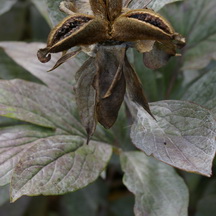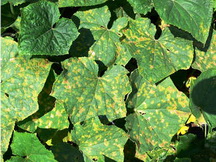|
Mildew Powdery or Downy
|
Powdery and Downy sound very similar but they are actually relatively easy to tell apart. They are both caused by a variety of different parasitic fungi that enjoy our vegetables and flowers as much as we do.

Powdery Mildew is by far the most common in our gardens and is easily identified by a white/grey powdery substance on the surface of the leaves. This ‘powder’ is actually the minute threads of the attacking fungus. There are a number of fungi responsible. They have amazing names such as Sphaerotheca fuliginea, which are basically irrelevant to most of us. That particular one attacks Cucumbers, melons and squash. Some are very host specific and others will attack a wide variety of plants. In food crops they can noticeably reduce yield if they attack early enough in the season. Unfortunately the chances of fighting these attackers in a home garden setting are very slim. They are usually too well established by the time we notice them and I certainly don’t want to pump a huge quantity of chemical fungicides into my garden just to get a few more cucumbers. I often see them as a friend as they kill off my gigantic, over producing Zucchini plants.
 Affected Flowers On ornamentals such as Phlox, Peony and Lilac they are, at worst, a bit unsightly later in the season but really do very little significant damage. Good cleanup of the infected foliage in the fall may help slow next years infection. Many of these fungi can only survive on living plant material and we usually see them later in the season as they have worked there way north from areas where these crops are grown earlier in the season. Good luck defending against that type of attack.
Affected Flowers On ornamentals such as Phlox, Peony and Lilac they are, at worst, a bit unsightly later in the season but really do very little significant damage. Good cleanup of the infected foliage in the fall may help slow next years infection. Many of these fungi can only survive on living plant material and we usually see them later in the season as they have worked there way north from areas where these crops are grown earlier in the season. Good luck defending against that type of attack.

Downy Mildew is less common on home garden vegetables but is a considerable problem in commercial production of Cucumbers and squash. The leaves develop brown to yellow lesions on the upper surface and the grey fuzz that gives ‘downy’ its name is present on the underside of the leaves.
Watch Your Coleus There was little cause for concern about Downy Mildew on ornamentals until the resurgence in popularity of Coleus. A strain of this disease has been found infecting most of these newly popular varieties given the appropriate conditions. High humidity and water film on the foliage lead to its spread of on Coleus.
 My Coleus are miserable this year, (2008) and we have set records for rainfall. I cannot positively identify this pathogen on my Coleus, they certainly exhibit some of the symptoms. Stunted leaves, irregular necrotic patches, leaf drop and some downy grey fuzz on the underside of the leaves. Will I undertake a fungicide spray program just because my planter of Coleus looks miserable? No. There’s always next year in any garden.
My Coleus are miserable this year, (2008) and we have set records for rainfall. I cannot positively identify this pathogen on my Coleus, they certainly exhibit some of the symptoms. Stunted leaves, irregular necrotic patches, leaf drop and some downy grey fuzz on the underside of the leaves. Will I undertake a fungicide spray program just because my planter of Coleus looks miserable? No. There’s always next year in any garden.
Although identifying and writing about gardening problems satisfies some of my scientific curiosity it can be a bit depressing when my own garden has so many examples available. The Zinnias, thankfully, have shown no signs of Mildew and are producing amazing flowers.
